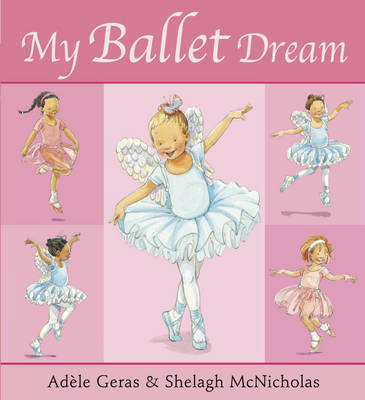I’ve turned all nice and pink. At least my mind gets a little pinker. Have some not bad pink tulips at the moment. The daffodils didn’t amount to anything – again – so I depend on my tulips. However, most of the pinkness has been on my desk, aka as the kitchen table. I stole a pink Marimekko folder off Daughter, and there was the unfortunate incident last year with me buying a pink blog diary. They go well together. Nicely complemented by the red plastic ‘thing’ Daughter made in school. I was about to chuck it (I’m not a nice person) when I thought it’d be good to put some of my smaller bits and pieces in. Or should that be on?
For a few days now I’ve had a beautifully pink book next to my tottering ‘admin piles’. Adèle Geras’s new ballet book was published this week, and I know I’m too old for this, but there is something irresistible about ballet and pink pictures. Although one little problem in this story about Tutu Tilly has to do with colour. But you know that problems in ballet picture books are there to be overcome. Everyone’s getting ready for The Recital, which is all Tilly can think about. Shelagh McNicholas’s illustrations for My Ballet Dream are perfect and adorable and very pink. I love them. Maybe I was deprived when I was the right age for pink and ballet? I’m simply compensating, however belatedly.
Speaking of belated; I have totally omitted to put up the poster for Liz Kessler’s blog tour. It’s the bus coming in threes syndrome again. There is either too much to blog about, or too little. But, all is not lost. The tour is still on the road, so I’m not shutting the stable door after the horse has bolted. Or something.
In order to avoid repeating this next weekend I will post another poster while the posting is good. Who knows what will happen next? That was a rhetorical question. I’m a witch. I know. Just not saying. Blog tour posters come in twos, and I offer you Gillian Philip’s.
Hmm, this business of posting pictures is fun. Let’s continue. I got this one of Theresa Breslin the other week. She is posing with two of the boys who are in her Divided City play; one of each colour, which in Glasgow is deadly serious stuff. At least none of them are pink. I don’t even know what football is, so will say nothing about their shirts except to say that they both look lovely. So does Theresa, although she’s done that thing and changed her hair. How can I not walk past her?
I see those boys are in agreement about which beer to drink. It is beer, isn’t it? In which case you didn’t see it here.
From Glasgow it’s not far at all to Cumbernauld. I know, because I once visited a petrol station there. Cumbernauld has a famous son, who apparently likes ferrets. I offer you this ferret plate (yes, really) courtesy of Ebony McKenna, who writes books about a ferret. A very fanciable ferret. Remember Hamish? Book two is out now. (Watch this space.) Anyway, plate man is called Craig Ferguson, and he’s quite cute here on his plate. Mad, obviously. Lovely accent. Just like Hamish.
Notice how the pictures got bluer as we went from girls to boys?




















